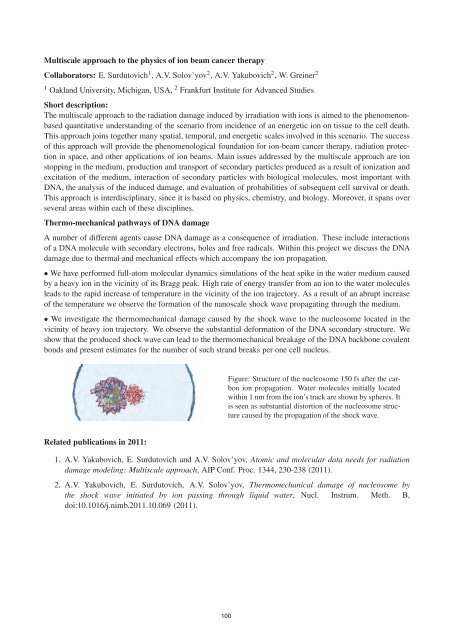FIAS Scientific Report 2011 - Frankfurt Institute for Advanced Studies ...
FIAS Scientific Report 2011 - Frankfurt Institute for Advanced Studies ...
FIAS Scientific Report 2011 - Frankfurt Institute for Advanced Studies ...
Create successful ePaper yourself
Turn your PDF publications into a flip-book with our unique Google optimized e-Paper software.
Multiscale approach to the physics of ion beam cancer therapy<br />
Collaborators: E. Surdutovich 1 , A.V. Solov’yov 2 , A.V. Yakubovich 2 , W. Greiner 2<br />
1 Oakland University, Michigan, USA, 2 <strong>Frankfurt</strong> <strong>Institute</strong> <strong>for</strong> <strong>Advanced</strong> <strong>Studies</strong><br />
Short description:<br />
The multiscale approach to the radiation damage induced by irradiation with ions is aimed to the phenomenonbased<br />
quantitative understanding of the scenario from incidence of an energetic ion on tissue to the cell death.<br />
This approach joins together many spatial, temporal, and energetic scales involved in this scenario. The success<br />
of this approach will provide the phenomenological foundation <strong>for</strong> ion-beam cancer therapy, radiation protection<br />
in space, and other applications of ion beams. Main issues addressed by the multiscale approach are ion<br />
stopping in the medium, production and transport of secondary particles produced as a result of ionization and<br />
excitation of the medium, interaction of secondary particles with biological molecules, most important with<br />
DNA, the analysis of the induced damage, and evaluation of probabilities of subsequent cell survival or death.<br />
This approach is interdisciplinary, since it is based on physics, chemistry, and biology. Moreover, it spans over<br />
several areas within each of these disciplines.<br />
Thermo-mechanical pathways of DNA damage<br />
A number of different agents cause DNA damage as a consequence of irradiation. These include interactions<br />
of a DNA molecule with secondary electrons, holes and free radicals. Within this project we discuss the DNA<br />
damage due to thermal and mechanical effects which accompany the ion propagation.<br />
• We have per<strong>for</strong>med full-atom molecular dynamics simulations of the heat spike in the water medium caused<br />
by a heavy ion in the vicinity of its Bragg peak. High rate of energy transfer from an ion to the water molecules<br />
leads to the rapid increase of temperature in the vicinity of the ion trajectory. As a result of an abrupt increase<br />
of the temperature we observe the <strong>for</strong>mation of the nanoscale shock wave propagating through the medium.<br />
• We investigate the thermomechanical damage caused by the shock wave to the nucleosome located in the<br />
vicinity of heavy ion trajectory. We observe the substantial de<strong>for</strong>mation of the DNA secondary structure. We<br />
show that the produced shock wave can lead to the thermomechanical breakage of the DNA backbone covalent<br />
bonds and present estimates <strong>for</strong> the number of such strand breaks per one cell nucleus.<br />
Related publications in <strong>2011</strong>:<br />
Figure: Structure of the nucleosome 150 fs after the carbon<br />
ion propagation. Water molecules initially located<br />
within 1 nm from the ion’s track are shown by spheres. It<br />
is seen as substantial distortion of the nucleosome structure<br />
caused by the propagation of the shock wave.<br />
1. A.V. Yakubovich, E. Surdutovich and A.V. Solov’yov, Atomic and molecular data needs <strong>for</strong> radiation<br />
damage modeling: Multiscale approach, AIP Conf. Proc. 1344, 230-238 (<strong>2011</strong>).<br />
2. A.V. Yakubovich, E. Surdutovich, A.V. Solov’yov, Thermomechanical damage of nucleosome by<br />
the shock wave initiated by ion passing through liquid water, Nucl. Instrum. Meth. B,<br />
doi:10.1016/j.nimb.<strong>2011</strong>.10.069 (<strong>2011</strong>).<br />
100
















